Waterfowl sportsman have greatly changed from the days of market hunters where the daily goal was simply to put huge numbers of birds on the ground in an attempt to satisfy the family dinner needs. Of course, today’s waterfowl hunters are strictly limited by migratory bird regulations restricting waterfowl hunting to non-toxic shot with very reduced bag limits on both ducks and geese.
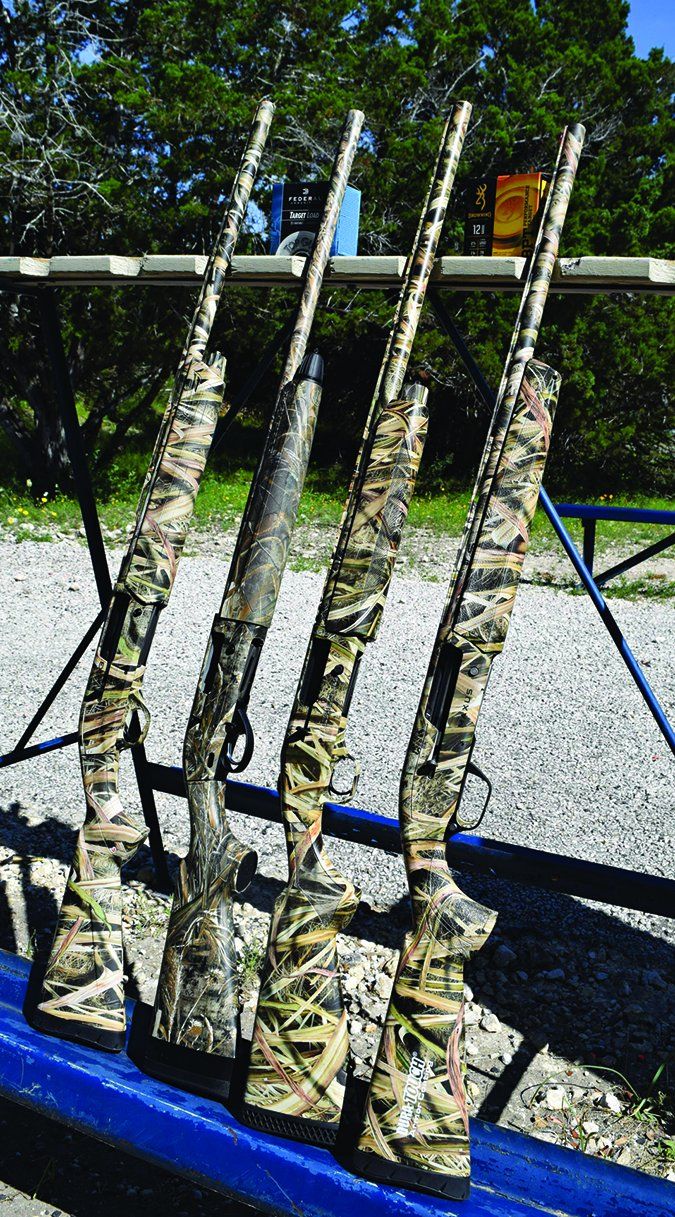
In a way, semiautomatic shotguns designed for waterfowl hunters are like little babies in a beauty pageant. While the parents may think their youngster is the cutest thing on the planet, the pageant judges always apply their own standards and personal preferences in selecting the best in show. This similarity was brought to our attention when a reader asked for a ranking of the best semiautomatic 12-gauge shotguns for bringing down ducks and geese. Without specifying some parameters — such as most used, best handling, affordability, reliability, and a variety of other factors — there can be no single best waterfowl semiautomatic. However, to provide our readers with some options in selecting their best smokepole, we were able to come up with a comparison of four popular, moderately priced semiautomatic waterfowl shotguns. The models included a Browning Maxus, listing for $1520; a Mossberg Model 930 Waterfowl, listing for $797; a Beretta Model A300 Outlander, listing for $845; and a Winchester Super X3, with a suggested retail of $1200. Each was found to feature both favorable and unfavorable elements that varied in importance with each member of our test team. In the end, the patterning-board performance and pocketbook impact proved to be the main separating factors in our ranking.




Our selection of ammunition to test the functioning ability, patterning performance and felt recoil of the semiautomatics included both clay-target loads and a typical waterfowl load. For clays, we used the recently introduced Browning BPT 2.75-inch, 3 dram equivalent loads packing 1 1/8 ounce of No. 7.5 shot with an average muzzle velocity of 1200 fps; and B&P Competition One 2.75-inch, 28-gram loads featuring 1 ounce of No. 7.5 shot with an average muzzle velocity of 1160 fps. To test the shotguns with duck loads, we selected Federal Premium Tungsten 3-inch, 3 dram equivalent No. 2 shot loads with an average muzzle velocity of 1,400 feet per second. Here are our findings:
Browning Maxus Mossy Oak Shadow Grass Camo No. 011645305 12 Gauge, $1520
GUN TESTS GRADE: A

Edged out of the top spot by the thinnest of margins, this shotgun handled well, patterned well, and functioned flawlessly. The bigger price was the factor that kept the Browning from being at the top of this quartet.
| ACTION TYPE | Semiautomatic PowerDrive gas system |
| CHAMBER SIZE | 2.75 to 3 in. |
| OVERALL LENGTH | 47.25 in. |
| CAPACITY | 4+1 |
| WEIGHT (UNLOADED) | 7 lbs. |
| BARREL LENGTH | 26 in. |
| BARREL | Steel; Dura-Touch Mossy Oak Shadow Grass Blades finish |
| RECEIVER | Aluminum alloy; Dura-Touch Mossy Oak Shadow Grass Blades finish |
| CHOKE | Screw-in flush fit invector-plus, IC, mod, full |
| BUTTSTOCK LENGTH OF PULL | 14.25 in. |
| BUTTSTOCK DROP AT COMB | 1.75 |
| BUTTSTOCK DROP AT HEEL | 2 in. |
| FOREARM | Dura-Touch Mossy Oak Shdow Grass |
| FOREARM LENGTH | 12.75 in. (textured) |
| FRONT SIGHT | Red-fiber-optic bar |
| MID-BEAD | White |
| RIB WIDTH | 1/4 in. |
| TRIGGER PULL WEIGHT | 5 lbs.; gold finish |
| WARRANTY | 1 year limited |
| TELEPHONE | (800) 333-3288 |
| WEBSITE | Browning.com |
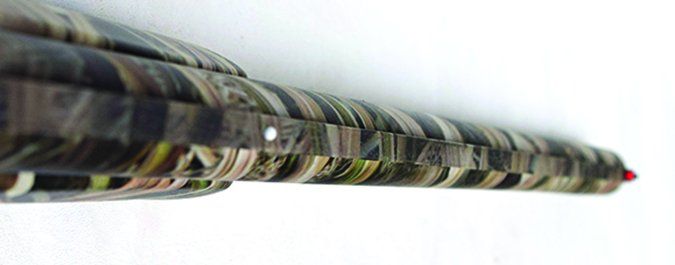
The looks and feel of this Browning semiautomatic are a tribute to the legendary inventor and company founder John M. Browning.
The Dura-Touch camouflage finish was both attractive and highly functional. It is truly a non-slip, tough finish that will hold up even under rugged use.
Sporting an aluminum alloy receiver and a 26-inch barrel, the Browning tipped the scales at an even 7 pounds. The overall length of 47 inches, with a length of pull of 14.25 inches; drop at the comb of 1.75 inches; and drop at the heel of 2 inches provided a pleasant shooting platform for all members of our team.
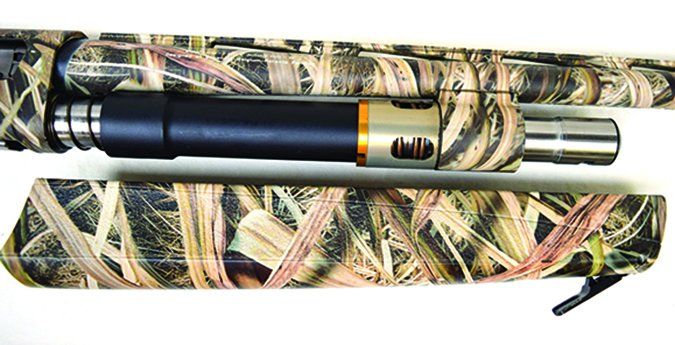
The Browning features a Speed Lock system that allows easy removal and replacement of the synthetic forearm. Quicker than unscrewing a magazine cap, this system was a nice touch for a fine functioning firearm.
Breaking at a crisp 5 pounds, the trigger pull of the Browning lived up to the advertising as a “Lightning Trigger” and was appreciated by our shooting team. Although it is more important when shooting a rifle or handgun; a pleasant, crisp trigger pull will also help a shooter smoothly break targets or knock birds out of the sky. We noted that clay target hits, using the modified choke, were very solid and consistent.
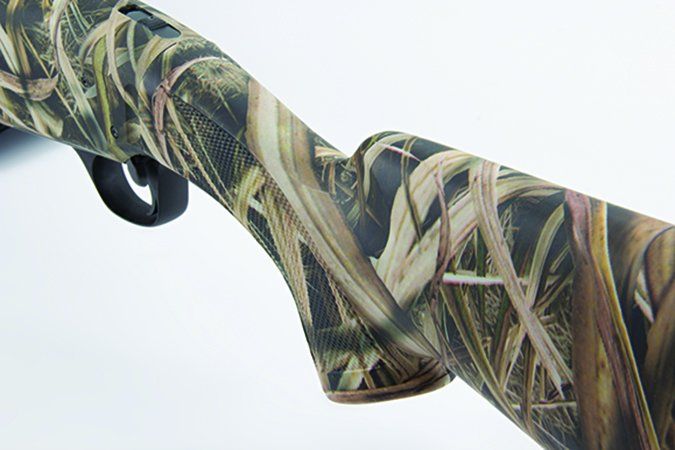
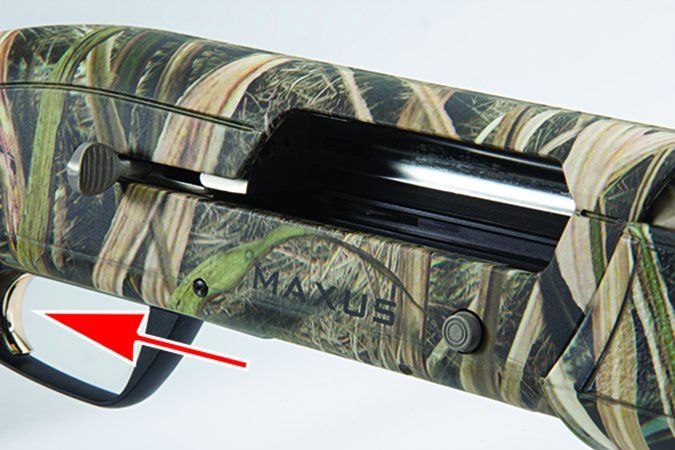
Felt recoil with the Browning, even with the heavy waterfowl loads, was not excessive and was among the lightest of the semiautomatic quartet.
On the patterning board, the Browning’s modified barrel produced a very solid pattern with a 20-inch circle with both the target loads and waterfowl steel shot. In both cases the pattern was right at 60-40, with 60 percent of the hits above the center of the target and 40 percent below. We found only one 3-inch hole in the pattern — in the upper right quadrant — with the target load and only one No. 2 steel flyer — high left — outside the 20-inch circle. Such a solid pattern could be the main reason that target hits were both impressive and common with the Browning on the clay target range.
Our Team Said: The highest priced model in the group, we feel the Browning is well worth considering if price is not a potential waterfowl hunter’s sole determining factor. We found that on the clay target field and on the patterning board, the Browning provided a superb shooting platform, excellent functioning and very fine pellet performance.
Mossberg Model 930 Waterfowl Mossy Oak Shadow Grass Camo No. 85212 12 Gauge, $797
GUN TESTS GRADE: B

If cost is the predominant factor in a waterfowl hunter picking a shooting tool, the Mossberg is a very capable and effective choice. Just a little heavier and slightly lacking the glide factor of the other test shotguns. We were disappointed in the patterning with both clay-target and waterfowl loads.
| ACTION TYPE | Semiautomatic |
| CHAMBER SIZE | 2.75 to 3 in. |
| OVERALL LENGTH | 48.5 in. |
| CAPACITY | 5 |
| WEIGHT (UNLOADED) | 7.75 lbs. |
| BARREL | 28 in. long; ported; Mossy Oak Shadow Grass Camo finish |
| RECEIVER | Mossy Oak Shadow Grass Camo finish |
| CHOKE | Screw-in Accu-set (IC, mod, full) |
| BUTTSTOCK | Mossy Oak Shadow Grass Camo |
| BUTTSTOCK LENGTH OF PULL | 14 in. |
| BUTTSTOCK DROP AT COMB | 1.25 in. |
| BUTTSTOCK DROP AT HEEL | 2.25 in. |
| FOREARM LENGTH | 11 in. long; Mossy Oak Shadow Grass Camo finish |
| FRONT SIGHT | Red fiber optic bar |
| MID-BEAD | None |
| TRIGGER PULL WEIGHT | 5.75 lbs.; black finish |
| WARRANTY | 2 year limited |
| TELEPHONE | (800) 363-3555 |
| WEBSITE | Mossberg.com |
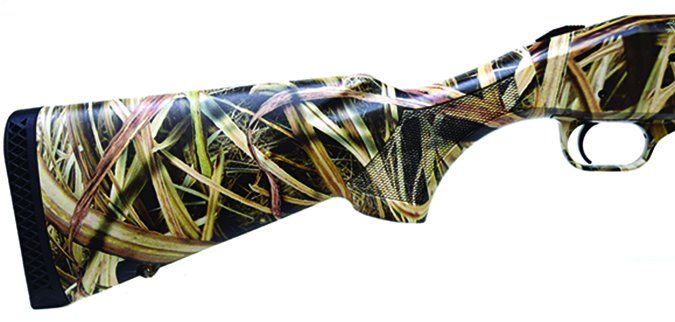
Our expectations were admittedly lower because of the Mossberg’s bargain basement price tag, but we have to admit the handling and performance of the semiautomatic was impressive. Not quite as smooth and balanced as the higher priced models in the test, the Mossberg did its job without fail. No jams, no hiccups and if the shooter did his job, the Mossberg responded in kind. As noted earlier, the Mossberg’s weight of 7.75 pounds, with a 28-inch barrel, made the shotgun feel slightly bulky and the glide factor was slightly less smooth than with the other members of the quartet.

With an overall length of 48.5 inches; a length of pull of 14 inches; a drop at the comb of 1.25 inches; and a drop at the heel of 2.25 inches, most of the members of our team were able to adjust to the dimensions without any major problems. The trigger pull was a little sluggish, breaking at 5.75 pounds. The thicker forearm and grip on the stock were noted — some shooters liked the features and others did not — and contributed to the overall bulky feel when putting the Mossberg through its paces on the clay target field. We found that with minor adjustments to our shooting style, the Mossberg could be relied upon to consistently break targets almost as well as the higher priced models in the quartet.
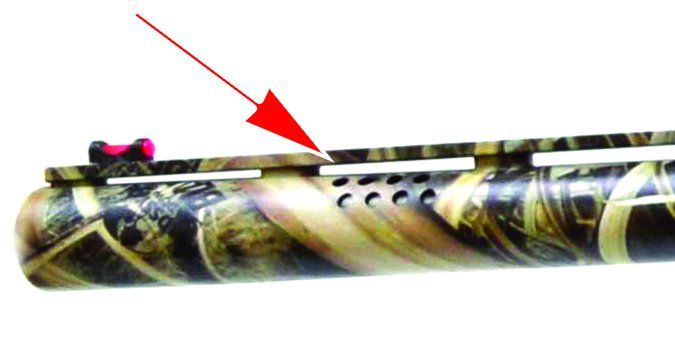
Patterning performance was a slight disappointment, with a 59-41 pattern using the clay target load and a 62-38 pattern with the steel shot. There was one 3-inch hole in the upper right quadrant of the lead shot pattern and eight hits outside the 20-inch center circle — mainly to the right. Not quite as tight as the Browning, but not considered a deal killer. Just like the Winchester and Browning, the Mossberg features a red fiber optic bar that is quite easy to see and allows for easy barrel alignment on targets.
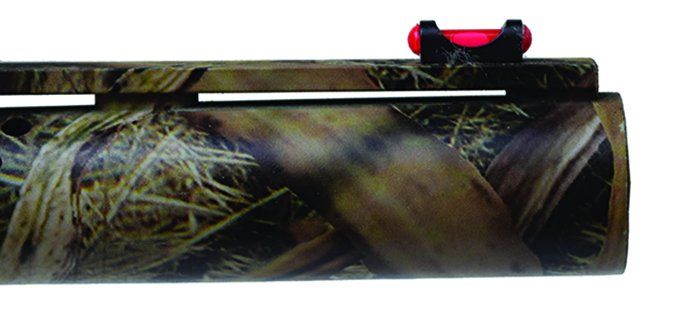
We noted that the checkering on the Mossberg’s forearm and stock was a little less sharp than we would have liked and did not have the comfortable feel of the Dura-Touch coating on the Winchester and Browning. It was about the same as the Beretta, although we did not think it severely hindered our handling of the shotgun or our target acquisition.
Our Team Said: Although the heft and feel of the Mossberg is not quite as comfortable as the higher end shotguns, it is a solid shooting tool capable of providing fine service on clays and birds — particularly for someone on a limited outdoor gear budget. We appreciated the feature of the safety on top of the receiver — easy and dependable access even when wearing gloves.
Beretta Model A300 Outlander Realtree Max5 Camo 12 Gauge No. J30TC18, $875
GUN TESTS GRADE: C

The Beretta’s tendency to jam when using light loads, greater felt recoil, and unimpressive patterning performance were all factors in its low rating. Although the shotgun handled well, recoil was the highest of all the shotguns in the test, even when the additional spacers were installed on the stock.
| ACTION TYPE | Semiautomatic |
| CHAMBER SIZE | 2.75 to 3 in. |
| OVERALL LENGTH | 46.75 in. |
| CAPACITY | 5 |
| WEIGHT (UNLOADED) | 6.75 lbs. |
| BARREL LENGTH | 28 in. |
| BARREL | Realtree Max5 camo |
| RECEIVER | Realtree Max5 camo |
| CHOKE | Screw-in (IC, mod, full) |
| BUTTSTOCK | Realtree Max5 camo |
| BUTTSTOCK LENGTH OF PULL | 13 to 14.5 in. |
| BUTTSTOCK DROP AT COMB | 1.5 in. |
| BUTTSTOCK DROP AT HEEL | 2.25 in. |
| FOREARM | Realtree Max5 camo |
| FOREARM LENGTH | 12 in. |
| FRONT SIGHT | Brass bead |
| MID-BEAD | None |
| TRIGGER PULL WEIGHT | 6.25 lbs.; silver trigger |
| WARRANTY | 1 year limited |
| TELEPHONE | (800) 237-3882 |
| WEBSITE | BerettaUSA.com |
| MADE IN | USA |
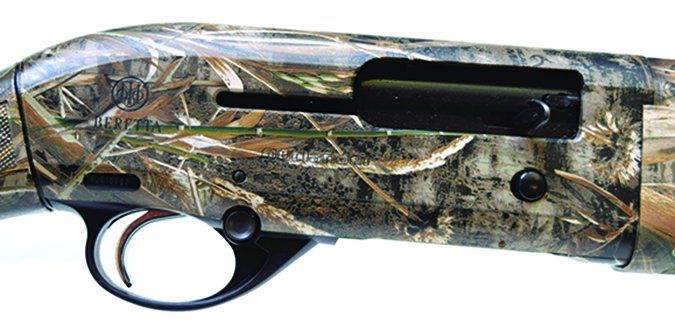
Tied with the Winchester as the two lightweight shotguns in the quartet, weighing in at just 6.75 pounds, the Beretta had a distinctive feel that was considered acceptable by some team members, but too light by others. As noted earlier, in most cases personal preference is the main individual factor that drives the ranking process of any shooting tool.

Overall, the looks and heft of the Beretta were acceptable and it appears the shotgun will hold up to the rugged conditions experienced during waterfowl hunting. The Beretta did not fare well in either the felt recoil ranking or the functioning testing. While recoil from the light target loads was about the same as the other shotguns in the quartet; when the heavy steel loads were fired there seemed to be more shoulder shock than we expected.
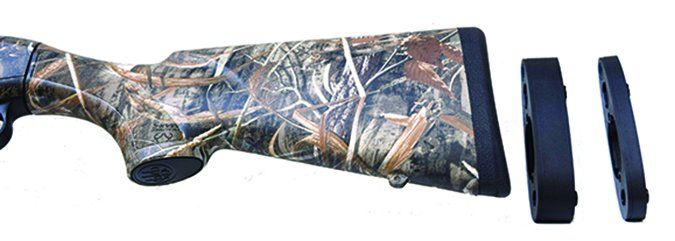
On the plus side, the Beretta ejected the waterfowl loads with authority. The same cannot be said for the clay target loads, with about one jam or stovepipe shell for every 6-8 fired rounds. Cleaning the Beretta did not alleviate the ejection problem with light loads and was one of our critical factors in ranking this semi-auto shotgun.
We did appreciate the inclusion of additional spacers to allow for adjusting the length of pull from a low of 13 inches to a maximum of 14.5 inches. However, even with the maximum use of the spacers, we felt recoil from the waterfowl loads was excessive. As for the fit of the shotgun, we were satisfied with a drop at the comb of 1.5 inches and a drop at the heel of 2.25 inches. The trigger pull of 6.25 pounds was crisp, but a lighter touch off would have been better.
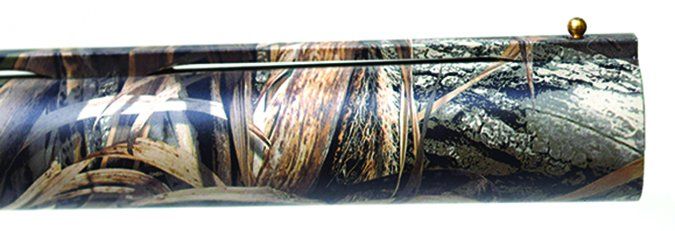
The 12-inch forearm and slim-grip stock, both in synthetic covered with Realtree Max5 camouflage, provided a satisfactory feel, although not as comfortable as the other shotguns. We also noted that after only a couple boxes of shells had been cycled through the action, there were several small scratches in the camouflage finish around the loading port.
In the patterning tests, the Beretta produced a 76-24 pattern — too high for our tastes — with the clay target load; and a slightly better 58-42 pattern with the steel No. 2 loads. There were eight, three-inch holes in the clay target load pattern, mainly in the low left quadrant of the 30-inch circle. In addition, there were five hits, also low right, outside the 20-inch circle with the steel loads.
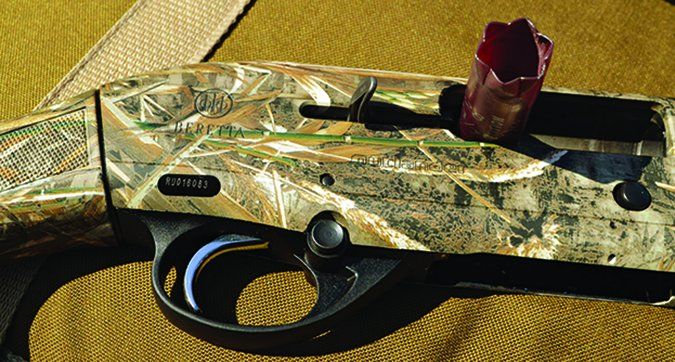
While we would not rank the patterning as terrible, we did note it was the worst of the test group.
Our Team Said: Sporting what we could consider a moderate to low price tag for a waterfowl shotgun, the Beretta performed reasonably well in our tests. We were satisfied with its handling ability, although there were problems with cycling some of the ammunition. The patterning test also found the Beretta at the tail end of our ranking, but only by a slight margin. Overall, we would rank the Beretta as an acceptable shooting tool, particularly for those on a limited budget.
Winchester Super X3 Waterfowl Hunter Mossy Oak Shadow Grass 511155291 12 Gauge, $1200
GUN TESTS GRADE: A

Excellent handling, very smooth and quick functioning, and a lower price were the trio of factors that pushed the Winchester to the top of our list.
| ACTION TYPE | Semiautomatic |
| CHAMBER SIZE | 2.75 to 3.5 in. |
| OVERALL LENGTH | 48.75 in. |
| CAPACITY | 5 |
| WEIGHT (UNLOADED) | 6.75 lbs. |
| BARREL | 28 in. long; Dura-Touch Mossy Oak Shadow Grass finish |
| RECEIVER | Aluminum alloy; Dura-Touch Mossy Oak Shadow Grass finish |
| CHOKE | Screw-in invector-plus (IC, mod, full) |
| BUTTSTOCK | Dura-Touch Mossy Oak Shadow Grass finish |
| BUTTSTOCK LENGTH OF PULL | 14.25 in. |
| BUTTSTOCK DROP AT COMB | 1.5 in. |
| BUTTSTOCK DROP AT HEEL | 2 in. |
| FOREARM | Composite; Dura-Touch Mossy Oak Shadow Grass finish |
| FOREARM LENGTH | 12.5 in. (textured) |
| FRONT SIGHT | Red fiber optic bar |
| MID-BEAD | None |
| TRIGGER PULL WEIGHT | 6 lbs.; black trigger |
| WARRANTY | 1 year limited |
| TELEPHONE | (800) 333-3288 |
| WEBSITE | WinchesterGuns.com |
| MADE IN | Portugal |
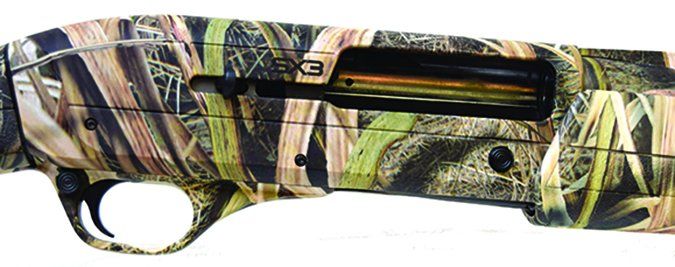
Billed as being able to cycle five rounds in less than half a second, this is a sleek, smooth and effective shooting tool.
Without question, the Winchester cycled both clay target rounds and heavy steel loads faster than any of the other shotguns in the test. Felt recoil was also the lightest of all the semiautomatics we put through their paces, our shooters said.

Sporting the same Dura-Touch finish as the Browning, we were pleased with the feel and handling ability of the Winchester. As veteran shooters can attest, sometimes a shotgun just feels like it belongs in your hands – this was the case with the Winchester.
With an overall length of 48.75 inches; a 28-inch barrel; a length of pull of 14.25 inches; a drop at the comb of 1.5 inches; and a drop at the heel of 2 inches, the fit was fine for all members of our team. We noted the trigger pull of 6 pounds was slightly heavier than we would have liked, but was very crisp and did not hinder our target-breaking abilities.
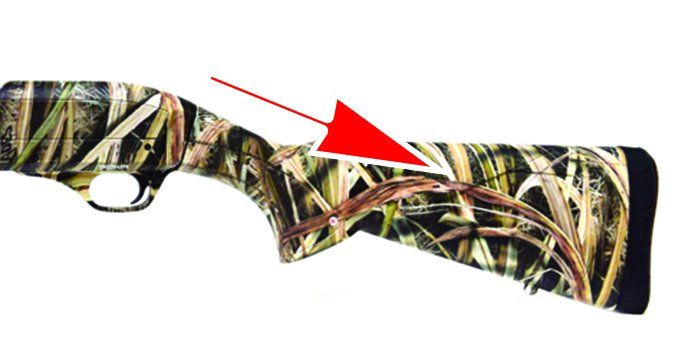
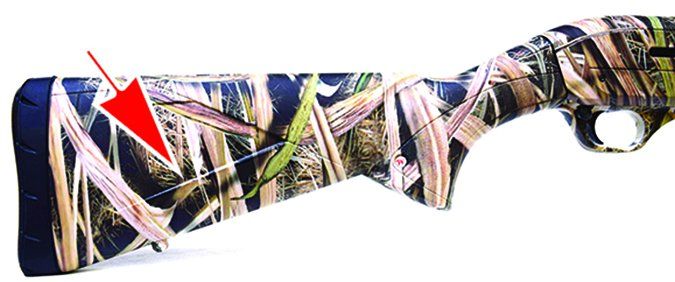
Quick to bring to bear on targets, the Winchester consistently broke more clays with more authority than any of the other shotguns in the quartet. While the old saying of “It is not the tool, it is the worker,” applies in most cases, having a good tool in your hands can’t hurt a shooter’s performance in the field.
The patterning board gave testament to why our clay target breaking success was high with the Winchester. The modified barrel produced a 60-40 pattern with the clay target shot and a 58-42 pattern with the steel shot. All of the steel shot was in a solid pattern within a 20-inch circle surrounding the center of the pattern paper and there were no holes in any of the quadrants with the clay target load.
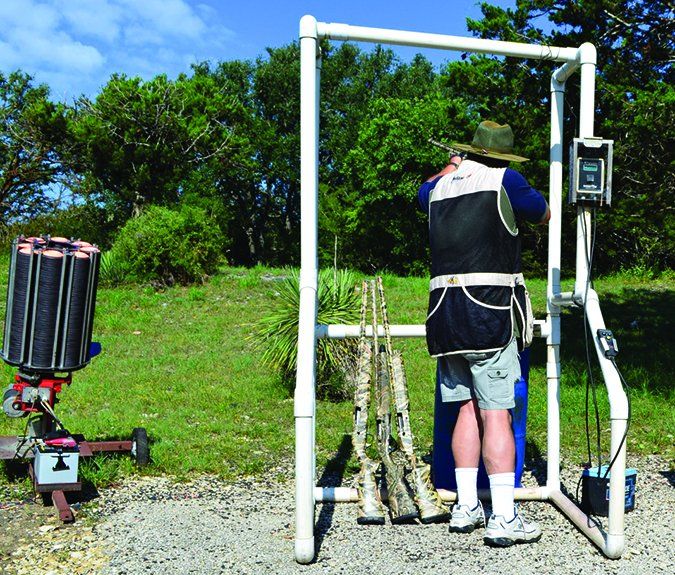
There were no malfunctions of any kind with any of the loads and, as noted earlier, the Winchester was the most fun to shoot of all the semiautomatics in the quartet.
Our Team Said: If feel, function and handling ability are key factors in a waterfowl hunter’s ranking, the Winchester easily makes the top of the list. A very fast and smooth action; good patterning and clay-busting performance; and providing the secure feel of a veteran smokepole all helped the Winchester reach the top spot in our ranking. The slightly lower price tag, compared to the Browning, also helped in our evaluation naming the Winchester our best of the best.
Written and photographed by Ralph Winingham, using evaluations from Gun Tests team testers.

























